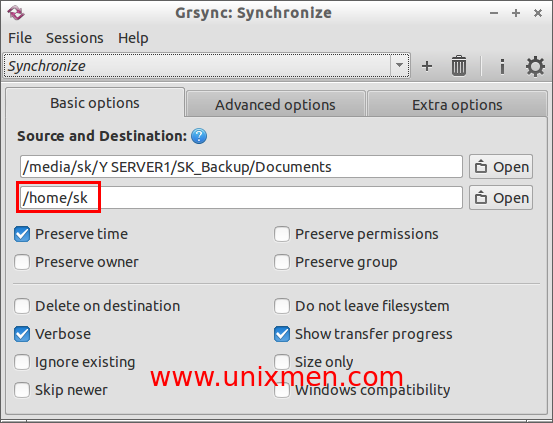

Instead of copying the test file it copied the entire source directory to the destination directory. Can you guess what happens if you omit the trailing slash? $ rsync -a source destination The trailing slash instructs rsync to copy all files (and directories) in the source directory. If you want to copy all files in the source directory to the destination directory then the source should include the trailing slash, like so: $ rsync -av source/ destination/ To illustrate the point, let’s create two directories ( source and destination) and create a file named testfile in the source directory: $ mkdir source destination It is very important to be aware of the function of the trailing slash in the source. If SELinux is enforced on your server then it is easier to use rsync, which does preserve the context. $ mv /home/example/public_html/wp/* /home/example/public_html/Ī second thing to note is that mv doesn’t preserve the SELinux context of files. In Bash, you can set the dotglob option to get mv to also move hidden files: $ shopt -s dotglob nullglob htaccess file is still sitting in the wp subdirectory. In the above example we moved all the files, but the. The first is that mv doesn’t move dotfiles by default: $ mv /home/example/public_html/wp/ /home/example/public_html/ There are two things to be aware of though. If you just want to move files it makes more sense to use the mv utility instead. In other words, the public_html/wp directory still contains all the original files.

It is worth mentioning that the data has been copied rather than moved. Copying about 45MB took about 1.5 seconds. Sent 44,901,625 bytes received 36,723 bytes 29,958,898.67 bytes/secĪs we added the -v option the output tells us which files were copied and how much data was transferred. You can sync all the files from the public_html/wp directory to the public_html directory in seconds: $ rsync -av /home/example/public_html/wp/ /home/example/public_html/
GRSYNC SKIP EXISTING INSTALL
However, it does mean that you have to move the files if you prefer to have the install in the public_html directory. Often that is useful, as the install will be separate from any existing files in the public_html directory.

By default Softaculous installs WordPress in a subdirectory with the name wp. This is something you may want to do after you have installed WordPress via Softaculous.
GRSYNC SKIP EXISTING HOW TO
To demonstrate how to use rsync we will copy an entire WordPress site to a different directory. You typically want to use this option, as it tells you what rsync is doing. As the name suggest, this option makes rsync produce lots of output – it prints all the files that are being synced and a summary of the amount of data transferred. Verbose outputĪnother commonly used option is -v ( -verbose). For instance, if you are syncing files to a remote system you may not want to preserve the group and owner data, as the same user and group might not exist on the remote system. This is a convenient shortcut but you don’t necessary want to use all these options. The -a option is a combination of a bunch of other options: -r Recurse into directories We will briefly look at these options before we get to some examples. Rsync is almost always run with one or more options. It can copy files locally as well as from one host to another.


 0 kommentar(er)
0 kommentar(er)
